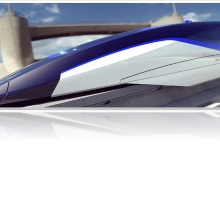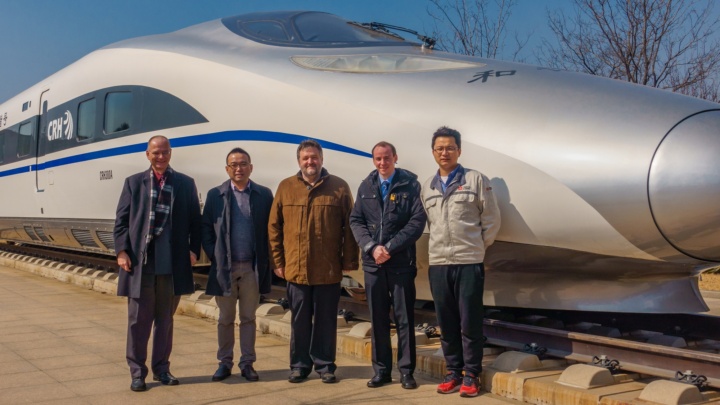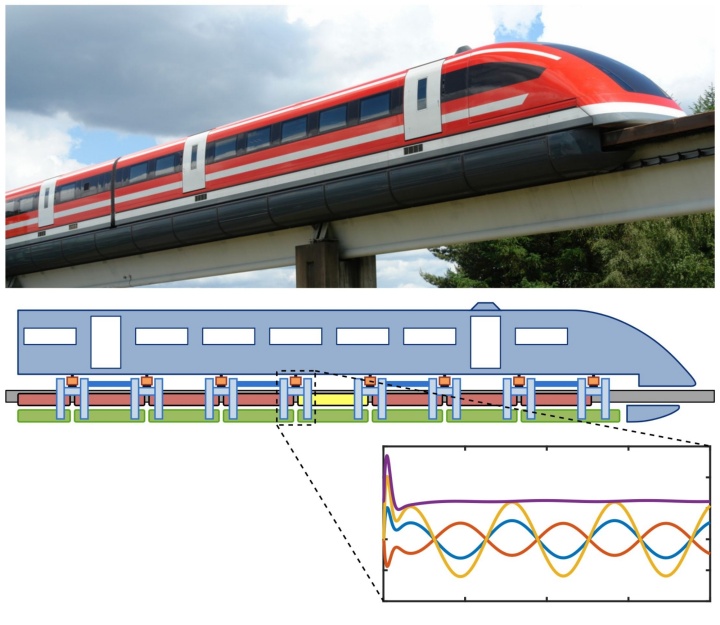Traveling by train at speeds previously only reached by aircraft; this might sound utopic in Germany, but a new type of maglev train being developed in China should make this a reality within the next ten years. The Institute of Engineering and Computational Mechanics (ITM) and the Institute of Railway and Transportation Engineering (IEV) at the University of Stuttgart are involved in this exciting project. The project team recently met in Qingdao.
Commissioned by the government of the People’s Republic of China, the China Railway Rolling Stock Corporation (CRRC), the world’s largest manufacturer of railway vehicles, has been working on the prototype for a new type of maglev train since 2016. In the future, this train will operate at average speeds of 550 km/h, with a top speed of 600 km/h, enabling it to cover great distances in just a few hours. This maglev train will be the fastest ground transportation system in the world.
This futuristic form of transportation will use magnetic forces to levitate, drive and brake and is based on a concept developed in 1934 by the Hermann Kemper, a German engineer and the inventor of magnetic levitating train. The so-called long stator principle involves using a stator to generate a magnetic field. Movement occurs through the interaction with the magnets on the vehicle, which correspond with the rotor in the alternating current synchronous motor. Because this movement requires no contact between the components, the vehicle must be lifted initially and then float the entire time it is moving. Regarding the various internal and external force effects, the distance between the track and the vehicle must be kept as even as possible in both horizontal and vertical orientations. Only then is safety, low wear and travel comfort ensured.
International regard
Diverse and often extremely complex engineering solutions are required to implement this challenging project. Founded in 2015, the Chinesisch-Deutsche Forschungs- und Entwicklungszentrum für Bahn- und Verkehrstechnik Stuttgart e. V. (CDFEB) – developed in cooperation with the University of Stuttgart, the Institute of Transport Research and the company CRRC – has been tasked with researching the most important aspects of this project relating to driving dynamics. The Institutes of Engineering and Computational Mechanics (ITM) and Railway and Transportation Engineering (IEV) at the University of Stuttgart are involved in these exciting technical and societal developments.
“Magnetic levitation trains have an eventful history in Germany and it is for political, rather than technical, reasons that the Shanghai maglev train is currently the only commercially operated high-speed maglev train in the world. It is a great honor and pleasure for us that we are able to use our knowledge and experience to aid the modelling, simulation and adjustment controlling for the next generation of these trains”, says the head of the Institute of Engineering and Computational Mechanics, Prof. Peter Eberhard. “That the Chinese company CRRC trusts us with this project demonstrates the international regard for our work.”
Prof. Ullrich Martin, Head of the Institute of Railway and Transport Engineering would very much like to see the technology implemented in Germany in the future: “As great as it is that global regard for German engineering knowledge of highly innovative transport system developments remains so strong, it is nevertheless profoundly regrettable that we in Germany often bask in our past achievements and view new innovative developments with increasing skepticism, while other countries are more willing to implement new and attractive solutions.”
Simulations using the institute’s software Neweul-M²
A fundamental focus of the cooperation between the various entities is the continuing conceptional detailing as the base for an adequate specification of the prototype and a dynamic analysis of the individual magnets used on the vehicle that will be developed from the prototype. The “Neweul-M²”, developed by ITM, will be used for modeling, control adjustments and the simulation of multi-body systems. The findings generated by the simulations will be repeatedly compared with measurement data from a test facility that is currently still under development. This process will determine the necessary prerequisites for a construction that is guaranteed to meet the respective requirements. The greatest challenge will involve controlling the amount of energy being generated as the speed increases, so that functionality, safety and travel comfort are guaranteed even under dynamic conditions.




